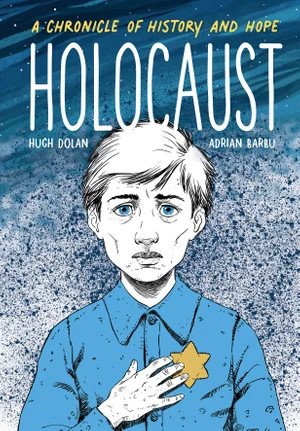Holocaust by Hugh Dolan and Adrian Barbu

Holocaust opens with a family enjoying their meal in a cafe “(somewhere) 2019”, the older boy, Thomas, mentions he is studying “The Warsaw Ghetto Uprising” at school. David, the man serving them, says “In 1943, I was there”. What follows is David’s story from when his Jewish family were thrown out of their village in Poland to his escape to a better life after the war. The black and white, lifelike illustrations bring immediacy to David’s story with a splash of blue colour clearly identifying him in each frame. He recounts the personal stories of Jews caught up in the conflict and how the rise of Nazism in Germany led to the dehumanisation of the Jews. Milestones along the way are described, including the enactment of the Nuremberg Laws in 1935 which stripped Jews of their rights as citizens and Kristallnacht where Jewish synagogues, businesses and homes were destroyed. Occasionally we see a frame with David speaking to Thomas in 2019 explaining a point. With the invasion of Poland and declaration of war in 1939 David’s father left to fight for his country, this is the last time he saw his father. What followed was the systematic persecution and killing of Jews throughout German occupied Europe, the graphics include maps and documents attesting to the numbers killed in each country and the named death camps where Jews were gassed. David’s family did not survive.
As a support to World War Two teaching material this slim graphic novel will be valuable, particularly to students from non-English speaking backgrounds and those who struggle with wordy texts. However, the material, while accurate and well researched, really needs to be viewed in historical context and younger children might find it disturbing.
Themes: War, Genocide, History, Family.
Sue Speck